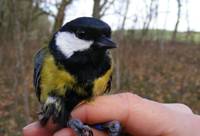Birdsong

12 December 2011
Birds that sing their songs at a higher pitch help them travel further in built-up areas.
Previously it was thought that great tits and other common birds sung at a higher pitch in noisy areas to avoid the low pitch noise from traffic and industry.
Now, scientists from Aberystwyth University and the University of Copenhagen have found that it is the buildings that are changing the way that birds sing in cities.
Their new study, published in the journal PLoS One, suggests that urban architecture may be just as important as background noise in shaping how our birds sing.
“Our cities are packed with reflective surfaces, open spaces and narrow channels, which you just don’t get in woodland. Because sounds bounce and travel in different ways, birds have to use songs that can cope with this”, says researcher Emily Mockford. “The higher notes mean the echoes disappear faster and the next note is clearer”.
A surprise result also showed that urban songs transmitted more clearly in woodland than the rural songs of the local birds. So why don’t rural birds also sing urban songs?
Dr Rupert Marshall, Lecturer in Animal Behaviour at Aberystwyth University, commented “In woodland where trees and leaves obscure the view, many species of songbird can tell how far away a rival is by how degraded its song is. In cities there are fewer visual obstacles and song doesn’t degrade as quickly, so city birds may just concentrate on being heard”.
City birdsong may be bouncing off the walls – but does it have the X factor?
PLoS ONE (eISSN-1932-6203) is an international, peer-reviewed, open-access, online publication. PLoS ONE features reports of original research from all disciplines within science and medicine. By not excluding papers on the basis of subject area, PLoS ONE facilitates the discovery of the connections between papers whether within or between disciplines.



